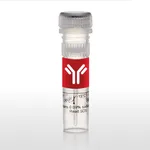Thermo Fisher Scientific Phospho-Tau (Ser416) Polyclonal Antibody
다른 상품 둘러보기
Applications
Tested Dilution
Publications
Western Blot (WB)
1:500-1:2,000
Immunohistochemistry (Paraffin) (IHC (P))
1:50-1:200
Immunocytochemistry (ICC/IF)
1:50-1:200
ELISA (ELISA)
1 µg/mL
Product Specifications
Species Reactivity
Human, Mouse, Rat
Host/Isotype
Rabbit / IgG
Class
Polyclonal
Type
Antibody
Immunogen
A synthetic phosphorylated peptide around S416 of human Tau (NP_0059012) if (typeof window.$mangular === undefined || !window.$mangular) { window.$mangular = {}; } $mangular.antigenJson = \[{targetFamily:Tau,uniProtId:P10636-1,ncbiNodeId:9606,antigenRange:416,antigenLength:758,antigenImageFileName:PA5-117246_Tau_P10636-1_Rabbit.svg,antigenImageFileNamePDP:PA5-117246_Tau_P10636-1_Rabbit_PDP.jpeg,sortOrder:1}\]; $mangular.isB2BCMGT = false; $mangular.isEpitopesModalImageMultiSizeEnabled = true;
View immunogen .st0{fill:#FFFFFF;} .st1{fill:#1E8AE7;}
Conjugate
Unconjugated Unconjugated Unconjugated
Form
Liquid
Concentration
0.71 mg/mL
Purification
Affinity chromatography
Storage buffer
PBS, pH 7.3, with 50% glycerol
Contains
0.01% thimerosal
Storage conditions
-20° C, Avoid Freeze/Thaw Cycles
Shipping conditions
Wet ice
RRID
AB_2901876
Product Specific Information
Positive Samples: NIH/3T3
Immunogen sequence: TGSID
Target Information
Tau is a neuronal microtubule-associated protein found predominantly on axons. The function of Tau is to promote tubulin polymerization and stabilize microtubules. The C-terminus binds axonal microtubules while the N- terminus binds neural plasma membrane components, suggesting that tau functions as a linker protein between both. Axonal polarity is predetermined by TAU/MAPT localization (in the neuronal cell) in the domain of the cell body defined by the centrosome. The short isoforms allow plasticity of the cytoskeleton while the longer isoforms may preferentially play a role in its stabilization. In its hyper-phosphorylated form, Tau is the major component of paired helical filaments (PHF), the building block of neurofibrillary lesions in Alzheimers diseases (AD) brain. Hyper-phosphorylation impairs the microtubule binding function of Tau, resulting in the destabilization of microtubules in AD brains, ultimately leading to the degeneration of the affected neurons. Numerous serine/threonine kinases phosphorylate Tau, including GSK-3beta, protein kinase A (PKA), cyclin-dependent kinase 5 (cdk5) and casein kinase II. Hyper-phosphorylated Tau is found in neurofibrillary lesions in a range and other central nervous system disorders such as Picks disease, frontotemporal dementia, cortico-basal degeneration and progressive supranuclear palsy.
⚠WARNING: This product can expose you to chemicals including mercury, which is known to the State of California to cause birth defects or other reproductive harm. For more information go to www.P65Warnings.ca.gov.
For Research Use Only. Not for use in diagnostic procedures. Not for resale without express authorization.
배송/결제/교환/반품 안내
배송 정보
| 기본 배송비 |
| 교환/반품 배송비 |
|
|---|---|---|---|
| 착불 배송비 |
| ||
| 교환/반품 배송비 |
| ||
결제 및 환불 안내
| 결제수단 |
|
|---|---|
| 취소 |
|
| 반품 |
|
| 환급 |
|
교환 및 반품 접수
| 교환 및 반품 접수 기한 |
|
|---|---|
| 교환 및 반품 접수가 가능한 경우 |
|
| 교환 및 반품 접수가 불가능한 경우 |
|
교환 및 반품 신청
| 교환 절차 |
|
|---|---|
| 반품 절차 |
|

